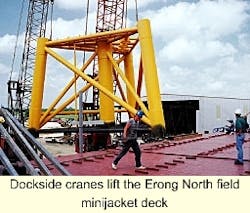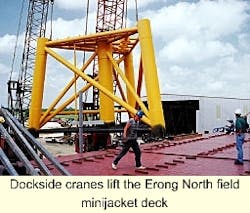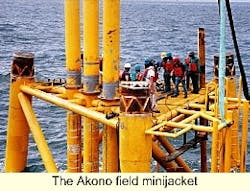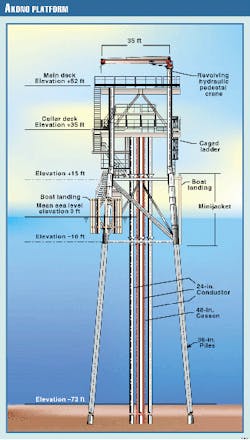Elf Serepca plans to install a minijacket in its operated Boa Sud field offshore Cameroon.
The VEST (very economical structural template) minijacket is a proprietary design of Paragon Engineering Services Inc. and is unique in that it has no mud mats. The structure rests entirely on a preinstalled caisson, while piles are driven through the pile sleeves of the jacket.
One reason the design was appropriate for offshore Cameroon was that the soft seabed soils found in the area would have required large, expensive mud mats to support the weight of conventional jackets, according to Paragon.
Paragon has designed the VEST minijacket for developing fields in water depths up to about 125 ft. It expects the design to cut project costs by some 20%, compared to conventional jackets.
Elf, together with its partners Pecten Cameroon, a subsidiary of Shell Oil Co., and Societe Nationale des Hydrocarbures (SNH), the Cameroon state oil company, previously installed VEST mini-jackets for developing the nearby Akono and Erong North fields (Fig. 1).
Boa Sud project
The Boa Sud project, 30 miles offshore, is in 70 ft of water. Drilling from the Boa Sud platform is scheduled to begin in March 2000.
Elf anticipates the new VEST technology will help compress the Boa Sud project schedule by several weeks.
Paragon is providing engineering and project management services for the fabrication, transport, and installation of the four-well, 50-ton tripod minijacket, along with piping to support a deck originally fabricated and installed on another platform.
The surplus deck for the Boa Sud platform will have test facilities that can handle 5,000 bo/d. Also planned is an 8-in., 5,200-m (3.23-mile) pipeline from the Boa Sud platform to Elf's existing KCF-1 platform.
Weight savings compared to a conventional jacket are substantial for the 50-tonne minijacket. Paragon estimates that the weight of traditional tripod jackets for the nearby Akono field, in 73 ft of water, and the Erong North field, in 46 ft of water, would have been 130 and 83 tonnes, respectively.
Minijackets
In terms of height, the VEST minijacket typically extends 15 ft above the water line and 10 ft below the water line (Fig. 2). For the Akono platform, the caisson diameter was 48 in.; however, Paragon says the design can accommodate a range of diameters, depending on site conditions.
It says a caisson can be pre-existing in the field or specifically installed for this purpose in a conventional manner with a lift vessel or a drilling rig.
The deck is installed on the minijacket and totally supported by the piles. Wells may be drilled through the caisson and conductor slots. Outboard wells may be added, but Paragon prefers wells incorporated within the minijacket.
The Akono platform was designed for seven well slots: caisson and three well slots within the jacket, and three well slots outboard of the jacket framing.
Each of the VEST minijacket projects to date has applied a tripod configuration. Paragon has designs for a four-leg configuration, however, that can accommodate a larger deck or additional well slots.
Paragon also notes the minijacket has the advantage that smaller, local fabricators can construct the structure, whose legs are only 25-ft long. In addition, smaller project ships or container ships can transport the structure, avoiding more costly barge and tug requirements for transporting larger structures.






